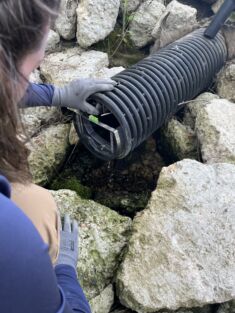A Wet and Busy Summer for Integrated Watershed Management Staff
The rain has certainly been keeping UTRCA stewardship field staff busy this summer as they perform routine water quality sampling for each major rain event that moves through the watershed. As rain falls and water levels rise, the concentration of nutrients flowing through watercourses, such as phosphorus and nitrogen, fluctuate with the addition of runoff from various sources, including agricultural fields and tile drainage.
From a stewardship perspective, it is important to understand the impacts of runoff at the field scale to surface water quality as a whole. During each rain event, water samples are collected and later sent to a lab for chemical testing. By taking several samples and monitoring water levels during an event, staff can better understand nutrient loading throughout these rain events.
This knowledge helps to inform stewardship staff in their efforts to encourage and support the adoption of Best Management Practices (BMPs) to improve overall watershed health. At our recent Clean Water Program meeting, over 40 BMP projects were approved across the watershed.
A look back at the 2022 field season helps put this season’s monitoring efforts into perspective. Last summer, staff collected data during five events from June through August, with approximately 60 water samples collected in that period. The dry conditions left sampling sites with flows either very low or non-existent.
In comparison, from June to mid-August of this year, 12 events have been captured with roughly 145 samples collected so far. The rain this summer has allowed for the collection of more than twice the number of data points as last year with even more rain in the forecast.

Additionally, efforts have been made this summer to establish a new monitoring site at the UTRCA-owned Thorndale Demonstration Farm. At the beginning of June, staff installed equipment at the Demo Farm where they will monitor tile drainage outlets from two halves of the field, each with different drainage types, including contoured controlled drainage and conventional drainage. This exciting project has been undertaken to better understand the differences between these farming practices and their respective impacts on storm water retention and water quality.
Staff look forward to continuing the field season, especially with the new monitoring project underway. It has been a busy but worthwhile summer for data collection!

